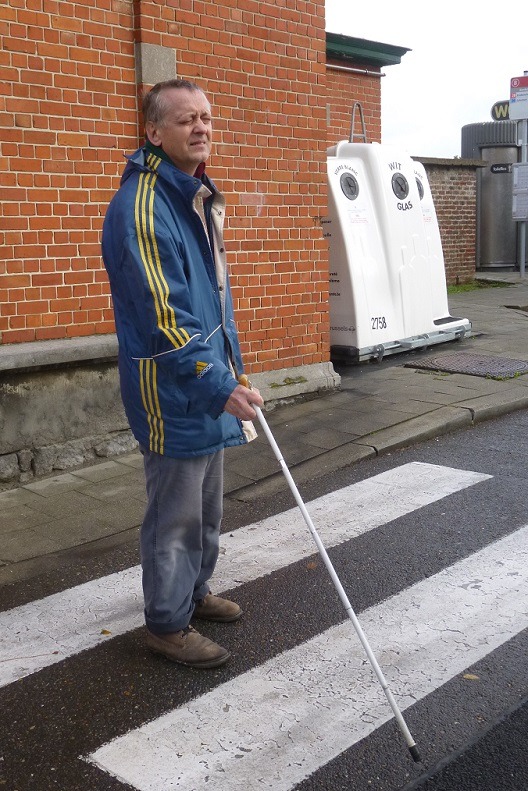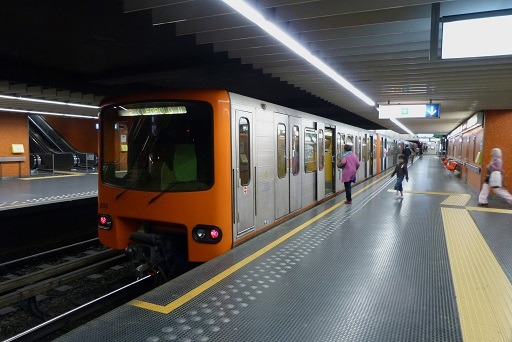Have you ever wondered what it must be like trying to get around Brussels, or any other Belgian city, if you are blind or partially sighted? The answer is probably, no. For able-bodied people this response may not be surprising but blindness is, of course, the sad reality facing thousands of, to use the jargon, “Persons with Reduced Mobility” (PRM).
According to the United Nations Convention on the Rights of Persons with Disabilities ratified by Belgium and its federated entities in 2009, access to public transport is an essential prerequisite for the full participation of persons with disabilities in society. Without accessible transport, people with disabilities cannot access employment, education, social and cultural life on an equal basis with others.
But living in a city like Brussels presents enormous challenges for people with disabilities. Everyday simple tasks such as taking the underground, responding to emails or going to a bar with friends can be stressful and time-consuming. One of the biggest problems for visually impaired people is isolation, both physical and social.
Testing Brussels
Even with a white cane or a guide dog, venturing into a shopping street, as I found when I posed as a blind man, can be an ordeal. The task was to see what problems the city as whole must overcome to help people with PRM.
My analysis of the accessibility of a business/building/transport was based on criteria such as the width of the door, possible existence of steps and internal/external space. The hand of friendship offered by citizens was something else I was keen to explore. The aim was to put Brussels’ credentials as a “user-friendly” city for the disabled to test.
The European Mobility Week took place from 16 to 22 September, paying specific attention to clean, shared and intelligent mobility, with the slogan “Sharing gets you further”. It did not take me long to discover that even the most routine tasks require a disproportionate level of planning.

Martin Banks testing the every day challenges of a blind or partially sighted person living in Brussels.
But, as I soon discovered, for blind and sight-impaired people, ordinary tasks such as entering shops and public buildings, crossing the road and taking public transport, can seem insurmountable if you do not receive the right support and training.
The first obstacle I encountered was crossing the busy Rue du Trone where, unknown to me, there was a huge hole in the road. I was about to fall head-first into the hole when a thoughtful passerby shouted and alerted me to the impending mini-disaster.
Getting about in the city is something most of us take for granted, but for the blind, new obstacles, everything from pot-holed pavements to posts and street furniture, can hinder your progress. Time after time, as I trekked around the city centre, I kept bumping into an assortment of posts, benches and poles along the pavement.
Trying to board a bus at Porte de Namur turned out to be a real headache. I asked someone in the queue to let me know when my bus arrived but, sadly, was met with indifference. The steps on the bus were uncomfortably high and it was difficult finding a seat.
Top marks, though, to the Inno store on rue Neuve, the city’s main shopping street. I found its wide aisles and large lifts made for a pleasant shopping experience. And at Casa, nearby, a shopper guided me to a cash till where an assistant also gave her full attention.
More could be done
Another plus, in some parts of the city at least, were the tactile markings on the road/pavement, the sound of the distinctive step edging making it much easier to navigate my way around. The pity, however, is that there are not more of these in the city centre. Non-slip surfaces in more places and more disabled toilets would be a big help, I thought to myself.
It also occurred to me that more colour contrasting would also help. This involves painting things like steps, door handles and frames in contrasting colours so that they can be picked out by someone with limited vision.

Since January 2012, one third of the city’s metro stations have been fitted with an elevator. Each station has floor marks, “alert lines” along the quays and guided lines that lead to signs in Braille. Visual and vocal announcement of stops and terminus are also installed in all metro carriages. Different stations are being constantly adapted.
Far more clearly-marked step edging, which would alert a blind person to obstacles in the pavement, would facilitate finding one’s way.
Brussels bills itself as a 24-hour city but various factors, including poor design, mean that its population with reduced mobility are not generally sharing in the fun.
One case in point is the multi-screen cinema near Avenue Louise, the city’s bustling commercial heart where – armed only with a white stick - an intimidating flight of steps posed an all-too familiar obstacle. Fortunately, a sloped entrance at the post office not far away made it more easily accessible, and the security guard could not have been more helpful.
When it came to trying to take a metro at Trone, I encountered problems of another kind. The only way to enter the station concourse was to descend a flight of steps crowded with scores of commuters and shoppers. A lift would have been very useful, it occurred to me.
So, despite valiant efforts to make the city’s transport, stores, eating places and public buildings more accessible - and the very well-meaning efforts of lots of people to lend a hand - it seems to me that too many visually-impaired people remain “prisoners in their own homes.”
It seems clear from my “experiment” that much still needs to be done to make the city more accessible for the disabled.
One blind man I encountered on my “day in the life of a blind person” told me: “Many people in Brussels are disabled, but I think most residents aren’t really aware of how they experience the city. Everything is different, everything is difficult. These people have enormous problems when it comes to mobility and participating in public life.”
For those who, like me during the short time I pretended to be blind, find it difficult to get about, help is at hand in the shape of “Brussels for All”, a guide book for people with reduced mobility.
My verdict? Lucky to be able to put my white cane to one side and resume “normality”, I could only reflect on the daily trauma – and sheer remarkable courage - of navigating life in Brussels for people who really are blind.
| What do the experts say? Having sampled, albeit just for a few hours, what life might be like for the blind in this city, I spoke to two organisations in Brussels whose mission is to help the visually impaired and others with some form of disability. Formerly the Interfederal Centre for Equal Opportunities, Unia is an independent public institution that combats discrimination and promotes equal opportunities. Since its creation in February 2016, it has mounted campaigns for equal opportunities and against discrimination. It handles problems of accessibility to public transport in Brussels, whether in terms of access to the physical environment, rolling stock or information and communication. One key aspect highlighted by Unia are the multiple transport issues facing the blind and other people with PRM. A spokesman said: “While significant efforts have been made over the last decade to improve the accessibility of the STIB network to people with disabilities, in particular by making investments in the accessibility of bus and tram lines, and access to metro stations, they are still insufficient and their effects are not sufficiently felt in the daily commuting of people with disabilities and with reduced mobility.” The accessibility of transport concerns many people - not only persons with disabilities (whether they have a motor, visual, auditory or intellectual disability - but also the elderly, parents with prams and people whose mobility is momentarily reduced. It is known that the measures taken to improve accessibility for people with disabilities or, better still, those that are designed at the outset, benefit everyone.” Unia points out that the United Nations Committee on the Rights of Persons with Disabilities has explicitly recommended that Belgium adopt a legal framework with specific and mandatory targets for accessibility of transport public. Public space and transport Another organisation flying the flag for the disabled is Bruxelles Mobilité. Inge Paemen, from Bruxelles Mobilité, said: “A disabled person is deemed to be anyone who experiences problems while moving around and who encounters difficulties with obstacles they cannot overcome without help.” “In Brussels, more than 30% of the population can be considered as disabled. Their mobility problems can be produced by temporary conditions such as illness, pregnancy, a broken leg etc or permanent handicap (illness, blindness, wheelchair, crutches), in short, all things that provoke restrictions on the mobility of a person.” She adds: “It is important to act since these temporary or permanently disabled people are dependent and their disability complicates their integration in society. Even the smallest trip can be a real problem and that’s the reason why Brussels Mobility maximises its efforts to simplify life for the disabled, especially in terms of mobility.” The organisation seeks to improve the accessibility of public space with, for example, tactile tiles, ground-floor guidance systems and sound signals at traffic lights. Brussels Mobility has also produced a guide to explain what problems come with what kind of handicap and the “technical” solutions to solve them. Inge says that people with disabled mobility “encounter lots of problems when moving in public space”, especially on public transport. “All new vehicles from MIVB/STIB are adapted for disabled people. In some cases, personal assistance is also possible.” Since January 2012, one third of the city’s metro stations have been fitted with an elevator. Each station has floor marks, “alert lines” along the quays and guided lines that lead to signs in Braille. Visual and vocal announcement of stops and terminus are also installed in all metro carriages. Different stations are being constantly adapted. All busses in Brussels, Inge says, now have low floors and the bus line No. 71 “is optimised for total accessibility” for wheelchair users, including collapsible slopes, cameras and light and sound signals. There’s also a special “TaxiBus” service to transport disabled people around the capital. This is available on demand, from door-to-door and offered from Monday-Saturday, from 5am to 1am. All new trams have lower floors and have collapsible slopes while, on the trains, personal assistance is available 7/7 “from the first train to the last” in 103 stations. About 100 taxis in the city are also equipped to transport wheelchairs, with their drivers specially selected to deal with wheelchair users. There are, says Inge, even streets in the Brussels Capital Region which are “entirely accessible” for someone in a wheelchair. “Since 2008,” she adds, “efforts have been made to make parks in Brussels accessible. These are: Elisabethpark, Koning Boudewijnpark, Scheutbos, Hallepoortpark, Pede-park and Abdij Ter Kameren. Further invaluable help for the visually impaired is at hand via another local organisation, Brailleliga, (www.braille.be) which helps the blind and sight-impaired to lead independent lives by providing tailored, one-to-one support. However, it still appears that too many businesses are unaware of the difficulties encountered by Persons with Reduced Mobility. |
By Martin Banks

